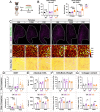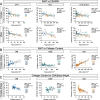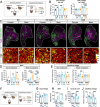Studying intramuscular fat deposition and muscle regeneration: insights from a comparative analysis of mouse strains, injury models, and sex differences
- PMID: 38812056
- PMCID: PMC11134715
- DOI: 10.1186/s13395-024-00344-4
Studying intramuscular fat deposition and muscle regeneration: insights from a comparative analysis of mouse strains, injury models, and sex differences
Abstract
Intramuscular fat (IMAT) infiltration, pathological adipose tissue that accumulates between muscle fibers, is a shared hallmark in a diverse set of diseases including muscular dystrophies and diabetes, spinal cord and rotator cuff injuries, as well as sarcopenia. While the mouse has been an invaluable preclinical model to study skeletal muscle diseases, they are also resistant to IMAT formation. To better understand this pathological feature, an adequate pre-clinical model that recapitulates human disease is necessary. To address this gap, we conducted a comprehensive in-depth comparison between three widely used mouse strains: C57BL/6J, 129S1/SvlmJ and CD1. We evaluated the impact of strain, sex and injury type on IMAT formation, myofiber regeneration and fibrosis. We confirm and extend previous findings that a Glycerol (GLY) injury causes significantly more IMAT and fibrosis compared to Cardiotoxin (CTX). Additionally, females form more IMAT than males after a GLY injury, independent of strain. Of all strains, C57BL/6J mice, both females and males, are the most resistant to IMAT formation. In regard to injury-induced fibrosis, we found that the 129S strain formed the least amount of scar tissue. Surprisingly, C57BL/6J of both sexes demonstrated complete myofiber regeneration, while both CD1 and 129S1/SvlmJ strains still displayed smaller myofibers 21 days post injury. In addition, our data indicate that myofiber regeneration is negatively correlated with IMAT and fibrosis. Combined, our results demonstrate that careful consideration and exploration are needed to determine which injury type, mouse model/strain and sex to utilize as preclinical model especially for modeling IMAT formation.
© 2024. The Author(s).
Conflict of interest statement
The authors declare no competing interests.
Figures






Similar articles
-
Muscle Resting and TGF-β Inhibitor Treatment Prevent Fatty Infiltration Following Skeletal Muscle Injury.Cell Physiol Biochem. 2019;53(1):62-75. doi: 10.33594/000000121. Cell Physiol Biochem. 2019. PMID: 31184447
-
Glycerol-induced injury as a new model of muscle regeneration.Cell Tissue Res. 2018 Nov;374(2):233-241. doi: 10.1007/s00441-018-2846-6. Epub 2018 May 12. Cell Tissue Res. 2018. PMID: 29754258 Review.
-
Comparative study of muscle regeneration following cardiotoxin and glycerol injury.Ann Anat. 2015 Nov;202:18-27. doi: 10.1016/j.aanat.2015.07.002. Epub 2015 Aug 21. Ann Anat. 2015. PMID: 26340019
-
Infiltration of intramuscular adipose tissue impairs skeletal muscle contraction.J Physiol. 2020 Jul;598(13):2669-2683. doi: 10.1113/JP279595. Epub 2020 Jun 3. J Physiol. 2020. PMID: 32358797 Free PMC article.
-
Targeting intramuscular adipose tissue expansion to preserve contractile function in volumetric muscle loss: A potentially novel therapy?Curr Opin Pharmacol. 2021 Jun;58:21-26. doi: 10.1016/j.coph.2021.03.006. Epub 2021 Apr 10. Curr Opin Pharmacol. 2021. PMID: 33848932 Review.
Cited by
-
Quantifying the recovery process of skeletal muscle on hematoxylin and eosin stained images via learning from label proportion.Sci Rep. 2024 Nov 7;14(1):27044. doi: 10.1038/s41598-024-78433-z. Sci Rep. 2024. PMID: 39511433 Free PMC article.
-
Multiomic Analysis of Calf Muscle in Peripheral Artery Disease and Chronic Kidney Disease.Circ Res. 2025 Mar 28;136(7):688-703. doi: 10.1161/CIRCRESAHA.124.325642. Epub 2025 Feb 18. Circ Res. 2025. PMID: 39963788 Free PMC article.
-
The matricellular protein ADAMTS-like 2 regulates differentiation of skeletal muscle-resident fibro-adipogenic progenitor cells.iScience. 2025 May 20;28(6):112712. doi: 10.1016/j.isci.2025.112712. eCollection 2025 Jun 20. iScience. 2025. PMID: 40520105 Free PMC article.
-
Spiny mice are primed but fail to regenerate volumetric skeletal muscle loss injuries.Skelet Muscle. 2024 Oct 29;14(1):26. doi: 10.1186/s13395-024-00358-y. Skelet Muscle. 2024. PMID: 39468576 Free PMC article.
-
Intrinsic Muscle Stem Cell Dysfunction Contributes to Impaired Regeneration in the mdx Mouse.J Cachexia Sarcopenia Muscle. 2025 Feb;16(1):e13682. doi: 10.1002/jcsm.13682. J Cachexia Sarcopenia Muscle. 2025. PMID: 39723578 Free PMC article.
References
-
- Metter EJ, Talbot LA, Schrager M, Conwit R. Skeletal Muscle Strength as a Predictor of All-Cause Mortality in Healthy Men. The Journals of Gerontology: Series A. 2002;57(10):B359–B365. - PubMed
-
- Reid KF, Martin KI, Doros G, Clark DJ, Hau C, Patten C, et al. Comparative effects of light or heavy resistance power training for improving lower extremity power and physical performance in mobility-limited older adults. J Gerontol A Biol Sci Med Sci. 2015;70(3):374–380. doi: 10.1093/gerona/glu156. - DOI - PMC - PubMed
Publication types
MeSH terms
Substances
Grants and funding
LinkOut - more resources
Full Text Sources
Molecular Biology Databases
Miscellaneous

